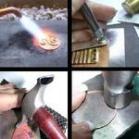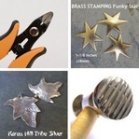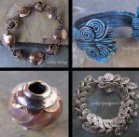Preventing Blue Patina from Coming Off
by Danielle
(Temecula, CA)
I have to know...on the bracelet "Aegean" how do you keep that beautiful blue copper color from coming right off? How does the moisture from one's skin affect the finish? And, do you have any experience using this finish on rings?
Stacy's Answer:
I have not used the blue patina on rings....actually, I've made very few rings. However, the patina does not wear off the area not in contact with the skin. Keep in mind that a lot of people react to copper or rather the copper reacts to them. Copper will oxidize very quickly when exposed to the salts and acids in perspiration and the environment, regardless of the patina on it. Patinas and oxidation are actually a kind of damage, if you will, to the surface of the metal. Some of them are just more desirable than others. The patinas don't peel up, but rather can change and continue to oxidize further.Some of the results are quite beautiful....some are not. In drier, cooler climes, copper and silver have a tendency to be rather maintenance free. Here in hot, humid and salty aired (coastal) Florida, copper and silver can require more cleaning and polishing.
To help maintain the finish, I do coat pieces such as the Aegean bracelet with a clear enamel lacquer. I have not had the lacquer coating peel off, but rather just sort of wear away over time on any high friction/sweaty areas. (gross, I know...but true!) I've tried commercial coatings and those specifically made for jewelry and have yet to find one that won't eventually wear away.
I don't think that the moisture from close contact with the skin will cause the coating to peel, but rather the exposure to the elements and a person's body chemistry — their perspiration, oils or acidity level — can damage the metal. I've seen this with karat gold too. The green or black residue left by copper, silver and karat gold does wash off the skin with mild soap and water.
















